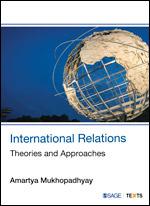Welcome to the companion website for International Relations: Theories and Approaches by Amartya Mukhopadhyay. Please note that all the materials on this site are especially geared toward maximizing your understanding of the subject covered.
This site offers a robust online environment you can access anytime, anywhere, and features an impressive array of resources to keep you on the cutting edge of your learning experience.
Instructors teaching by making it easy to integrate quality content and create a rich learning environment for students.

About the Book
A complete compendium on theories and approaches to international relations covering debates surrounding the major paradigms and latest developments.
Organized around the three paradigms of the discipline of international relations (IR)—realism, pluralism and globalism—this textbook offers a comprehensive and exhaustive coverage of the theories and approaches to IR, including their critiques and evaluations. By treating these theories and approaches under the canopy of the paradigms rather than in isolation, the book facilitates better understanding of their fundamental commonalities and divergences. It addresses the ongoing lively debates both inside and among the paradigms as well as the excessive American-centricity and Eurocentrism of the discipline of IR.
Written as an integrated, self-sufficient unit, this textbook will be a valuable companion for inquisitive undergraduate and postgraduate students, research scholars and teachers, who need not search for additional books and references.
Key Features:
- Careful organization of 15 theories into 3 positivist paradigmatic divisions, and treatment of 4 post-positivist theories to offer a comprehensive and logical approach to the entire subject
- Focus on non-Western traditions of IR thinking such as Kautilya from India, Han Fei from China and reference to India in the study of old regionalism
- Systematic browsing of relevant theoretical literature and current citations for every theoretical point made
- Additional features such as Word Help boxes and review questions to enhance teaching–learning experience
- Six chapters available on the companion website to address the needs of advanced readers
For instructors
Access resources that are only available to Faculty and Administrative Staff.
Want to explore the book further?

